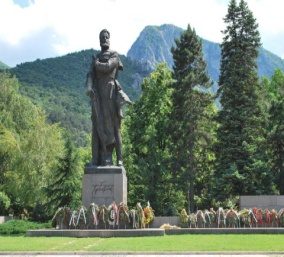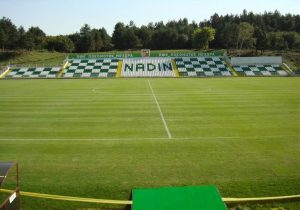

The monument of Hristo Botev is the first sculptural – architectural monument from the Principality of Bulgaria. The initiative for its construction belonged to the mayor of Vratsa, Zeno Leonkev and to the president of the Permanent Committee, Gyosho Antonov. The funds have been principally collected, from the donors, despite the fact that the initiative has been supported by Stefan Stambolov – a former close friend and associated of Hristo Botev who at the end of the decade was a prime – minister.
The monument has been inaugurated by the prince Ferdinand on 27.V.1890, and among the guests which were present there was the Prime – minister Stefan Stambolov, the mother of Botev, his wife, Veneta and his daughter, Ivanka.
The author of his sculpture was Gustav Eberlayn. At molding the head of Botev he received some kind of help from the young artists. The monument describes Botev in the natural scale. In his right hand he holds up his sword. The scattered leaves from his feet accentuate the decision of passing from words to facts. On the foundation of the monument there are inscribed the names of the 190 rebels and fighters and attached to the sculptures there are David Todorov, Mito Tsvetkov and the priest Costa Bouyuklyiski, and the plate is impressive with the heads of four lions and text, from whose mouth falls the clear water. The metal plates from the monument were written in Vienne.
The image of Botev is significantly different to the ones we used to know. The last photograph used by Botev was made at Bucharest, before the departure of the troop towards Bulgaria, where he was with his brothers, Stefan and Kiril Boyan.
He said the fact that in the last photographs Botev was quite thin at his face with the cut hair and with his characteristic mustache, but with a small beard and no trace of the relatively thick sideburns.
This image is not the only one in which Hristo Botev is described as being dead. At only a few months after his death, at the end of the year 1876, his first artistic image appears in the “Calendar year 1877”. These are the last messages of Zahari Stoyanov at the publishing of the book “Hristo Botev. Experience and biography” and the portrait sketch with the chalkstone by Anton Mitov, published in 1891 in the magazine “The light”.
Together with the inauguration of the monument, it is also said an interesting story about Botev by his rebel compatriot, Kaloferetsa Penko Minchev. After the defeat, he was captured in the proximity of Vratsa. He was taken at Ruse, where he was convicted to death at the insistence of Midhat Pașa. Later on he was taken at Constantinople, where the sultan himself wanted to see what people are in the “Committee”. The death punishment was commuted to sentence for life in the dungeons Diyarbakir. It is also convicted the brother of the commander of only sixteen years of age, Chiril Botev. The rebel Gyúró Nachev and Penko get away, pretending to be beggars and they save themselves at the Russian consulate, and the count Ignatiev gave them clothes and money and sent them to Bulgaria.
After the freeing, Penko Minchev coming back into his native city burned by the Turks and, like the majority of his comrades he lived in an extreme poverty. In 1890 at the opening of the monument of Hristo Botev Vratsa, it was invited a delegation from Kalofer, and he should have been included in the circulation. The mayor and the school, despite all these, didn’t say anything to Penko. The second day, he went on the field. A peasant passed by and laughed at him for not being a rebel, because he wasn’t invited to the unveiling of the monument. Only then, Penko Minchev understood why the nobles had questions regarding him.
With a bag on his shoulder, he walked through the mountain defiles, covering a large distance from Kalofer to Vratsa, in order to make a reverence to the tomb of the commander.
The monument was demounted in 1955 and at the beginning of the years ’90 he was placed in the “Russian” garden. On the 2nd of June, in the year 1964 it is unveiled the current monument from the market “Hristo Botev”.




